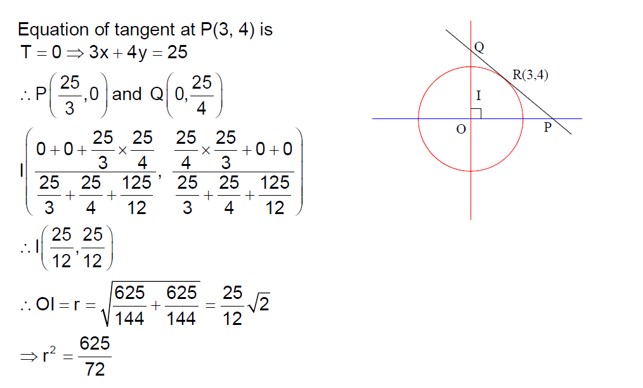Class 12th
Get insights from 12k questions on Class 12th, answered by students, alumni, and experts. You may also ask and answer any question you like about Class 12th
Follow Ask QuestionQuestions
Discussions
Active Users
Followers
New answer posted
2 months agoContributor-Level 10
As we know that direction of propagation of electromagnetic wave is perpendicular to plane containing mutually perpendicular electric field and magnetic field, so option D will be correct answer.
New answer posted
2 months agoContributor-Level 10
The problem provides an equation involving the coordinates (α, β, γ) of a point P:
((α + β + γ) / √3)^2 + ((α - nγ) / √(l^2 + n^2))^2 + ((α - 2β + γ) / √6)^2 = 9
The locus of P(α, β, γ) is given by replacing (α, β, γ) with (x, y, z):
((x + y + z) / √3)^2 + ((lx - nz) / √(l^2 + n^2))^2 + ((x - 2y + z) / √6)^2 = 9
This represents the equation of an ellipsoid. The text proceeds by comparing coefficients. By expanding the equation, the coefficients of x^2, y^2, z^2, and cross-product terms are collected. From the given conditions:
Coefficient of x^2: 1/3 + l^2 / (l^2 + n^2) + 1/6 = 1
Coefficient of y^2: 1/3 + 0 + 4/6
New answer posted
2 months agoContributor-Level 10
The numbers 1, log10(4^x - 2), and log10(4^x + 18/5) are in an Arithmetic Progression (A.P.).
This means that the corresponding numbers 10^1, 10^(log10(4^x - 2)), and 10^(log10(4^x + 18/5)) are in a Geometric Progression (G.P.).
So, 10, 4^x - 2, and 4^x + 18/5 are in G.P.
For a G.P., the square of the middle term is equal to the product of the other two terms:
(4^x - 2)^2 = 10 * (4^x + 18/5)
Let y = 4^x.
(y - 2)^2 = 10y + 36
y^2 - 4y + 4 = 10y + 36
y^2 - 14y - 32 = 0
(y - 16)(y + 2) = 0
So, y = 16 or y = -2.
Since y = 4^x, y must be positive. Thus, 4^x = 16, which gives x = 2.
The determinant calculation that follows appears to be unrelated to the
New answer posted
2 months agoContributor-Level 10
z = √ [R² + (X? - X? )²] = √ [6² + (4-10)²] = 6√2 Ω
Power factor = cosφ = R/z = 6/ (6√2) = 1/√2
New answer posted
2 months agoContributor-Level 10
Given matrices A = [[a, b], [c, d]] and B = [[α], [β]] where B ≠ [[0], [0]].
The product AB is:
AB = [[a, b], [c, d]] * [[α], [β]] = [[aα + bβ], [cα + dβ]]
From the problem statement AB = B, we have:
aα + bβ = α (i)
cα + dβ = β (ii)
Rearranging these equations:
(a - 1)α + bβ = 0
cα + (d - 1)β = 0
For this system of linear equations to have a non-trivial solution (since B is not the zero matrix), the determinant of the coefficient matrix must be zero.
det([[a-1, b], [c, d-1]]) = 0
(a - 1)(d - 1) - bc = 0
ad - a - d + 1 - bc = 0
ad - bc = a + d - 1
The provided text jumps to the conclusion ad - bc = 2020.
New answer posted
2 months agoContributor-Level 10
Given the integral In = ∫(log|x|)^n / x^19 dx.
Let t = log|x|, which implies x = e^t and dx = e^t dt.
The integral becomes:
In = ∫ e^(-20t) * t^n dt
Using integration by parts, where u = t^n and dv = e^(-20t) dt:
In = [t^n * e^(-20t) / -20] - ∫ n*t^(n-1) * e^(-20t) / -20 dt
In = e^(-20) / -20 - (n / -20) * In-1
20 * In = -e^(-20) + n * In-1
For n = 10: 20 * I10 = e^20 - 10 * I9 (Note: There seems to be a sign inconsistency in the original document's derivation vs. standard integration by parts, the document states e^20 instead of -e^(-20) and proceeds with e^20).
For n = 9: 20 * I9 = e^20 - 9 * I8
From these two equations, we can express e
New answer posted
2 months agoContributor-Level 10
I? = I? + I? ⇒ I? /I? = 1 + I? /I? ⇒ 1/α = 1 + 1/β = (β+1)/β ⇒ α = β/ (1+β)
⇒ 1/β = 1/α - 1 = (1-α)/α ⇒ β = α/ (1-α)
New answer posted
2 months agoContributor-Level 10
Find the number of solutions for 2tan(x) = π/2 - x in [0, 2π].
This is equivalent to finding the number of intersection points of the graphs y = tan(x) and y = (π/4) - x/2.
Let's sketch the graphs:
y = tan(x) has vertical asymptotes at x = π/2, 3π/2.
y = (π/4) - x/2 is a straight line with a negative slope.
At x=0, y=π/4.
At x=π/2, y=0.
At x=π, y=-π/4.
At x=2π, y=-3π/4.
By observing the graphs, there will be one intersection in (0, π/2), one in (π/2, 3π/2), and one in (3π/2, 2π].
Total number of solutions is 3.
Taking an Exam? Selecting a College?
Get authentic answers from experts, students and alumni that you won't find anywhere else
Sign Up on ShikshaOn Shiksha, get access to
- 65k Colleges
- 1.2k Exams
- 679k Reviews
- 1800k Answers


